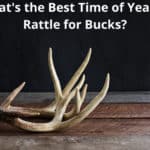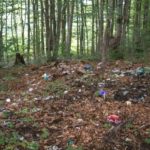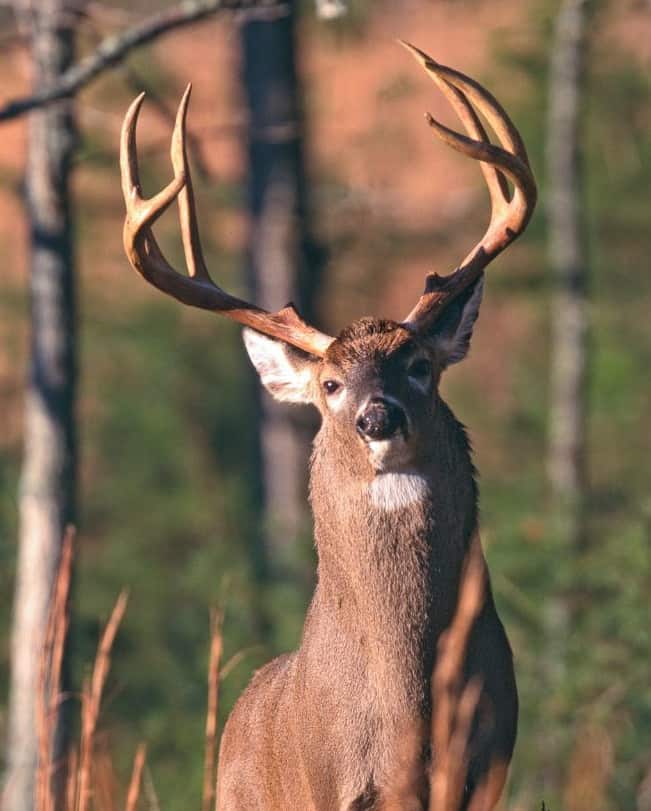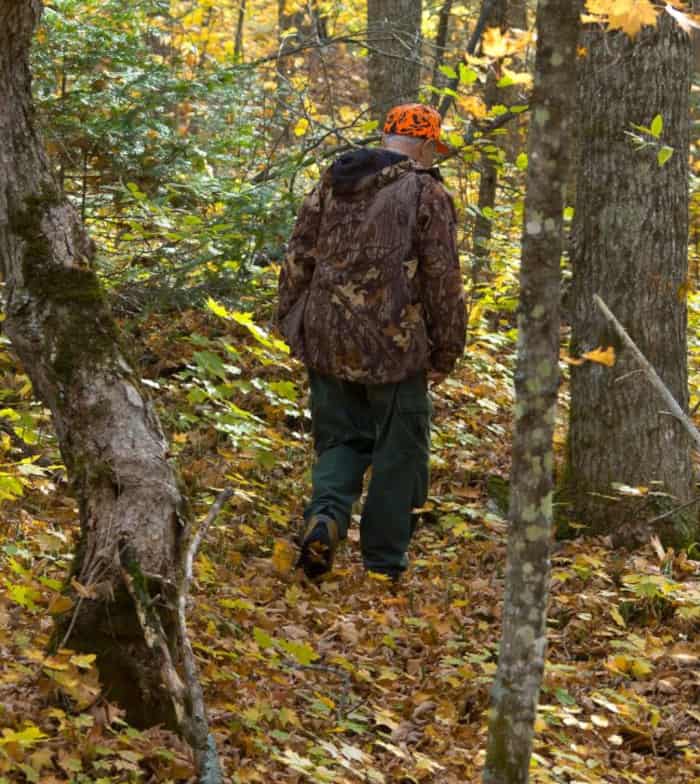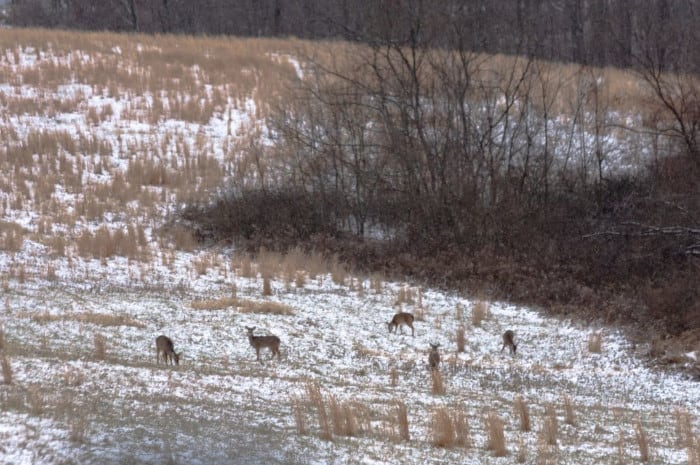Consistently successful deer hunting requires a variety of outdoor-based skills and diverse hunting techniques. Learning all the different tricks and tips of deer hunting is a lifelong process for most hunters as new tactics are constantly being introduced. However, one fundamental concept of deer hunting involves the use of deer scents and deer lures. In this post, I’m going to cover the following scent-related topics:
- A basic introduction of deer scents and deer lures
- A look at the different types of attractant scents that are common on the market
- How and when to use them for optimum success
- Some tips and tricks to get the most out of attractant scent products
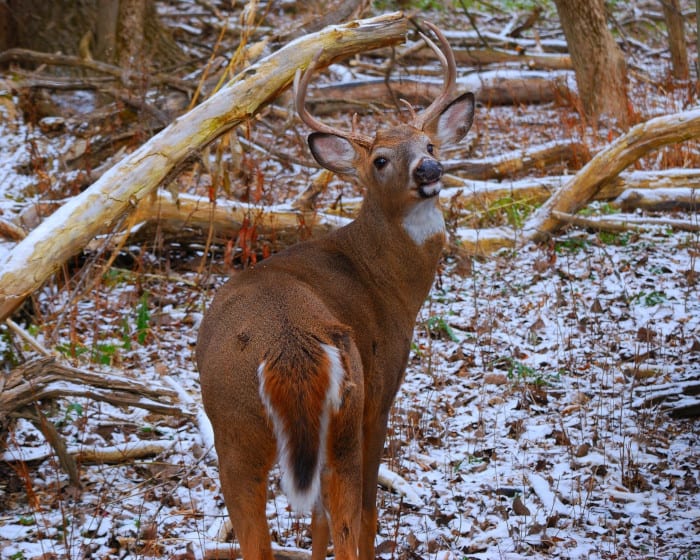
Understanding the Power of a Deer’s Sense of Smell
A Whitetail deer’s sense of smell is estimated to be around 3000 times more potent than a human and 1000 times more powerful than most dog species.
For better context, the average human being has approximately 5 million olfactory receptors, while most deer have an estimated number between 290 and 300 million receptors.
While deer rely on their eyes and ears as part of their defense against threats, their sense of smell is their primary defense mechanism for survival.
That same powerful sense of smell is also a primary method that deer use to do the following:
- Locate food
- Locate other deer
- Determine if a female deer is ready to mate
- Determine if a rival male deer (buck) has visited their territory
It only makes sense for a hunter to take advantage of that excellent sense of smell and potentially use it to lure deer to a specific location.
What is a Deer Scent or Deer Lure?
A deer scent is a commonly used term to describe a natural or artificial product designed to attract deer to a specific location through their keen sense of smell. A deer lure or deer attractant are other popular terms used to describe a deer scent product. For the purposes of this article, I’ll use these three terms with the same meaning and purpose.
These products are available in many different formats, including:
- Sprays
- Concentrated drops
- Paste
- Powder
The Difference Between Deer Scent and Cover Scent
Before I get too deep into this topic, I’d like to point out that deer scent lures are NOT the same as scent control, cover scents, or masking scents. Scent control is a term used to describe the techniques to cover up or remove traces of human scent from hunting clothes or gear. Cover scent is another term used to describe scent control to remove human odor.
Cover scents and scent control are separate topics worthy of an in-depth write-up.
Why Use a Deer Scent Product?
Scents and lures designed to attract deer have three primary purposes:
- Attract deer into a specific area or closer to your location.
- Hold a deer’s attention to help the hunter avoid detection.
- Potentially stop a deer or slow them down long enough for the hunter to take a shot.
These deer attraction scent products are most frequently utilized as a part of a hunting strategy where the hunter is attempting to draw the deer into a specific location where the hunter is positioned (usually in a tree stand or ground blind).
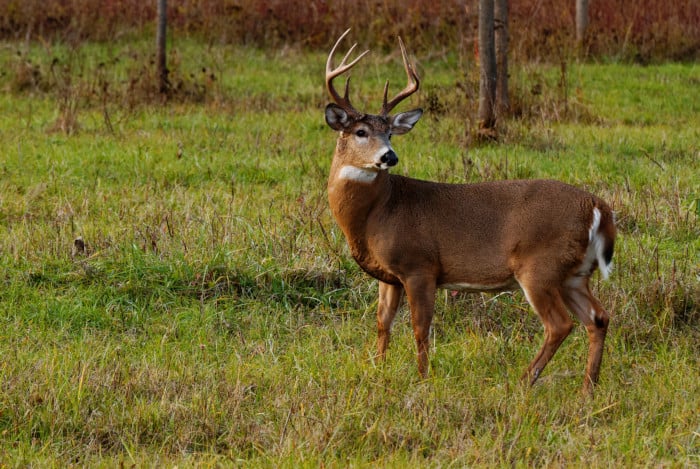
Deer Scent Types
Although there are probably thousands of different types, styles, and variations of these scents and attractants on the market, I generally group them into three broad categories:
- Mating Based Scents
- Food-Based Scents
- Unnatural Scents
Let’s discuss each lure scent in more detail:
Mating Based Scents
Mating scents or lures are also commonly called deer sex scents. This scent product category primarily focuses on urine-based scents of does and bucks. The most popular type of scent in this category is doe-in-heat or doe-in-estrus urine, designed to attract bucks looking for a doe in estrus for mating. The second most popular scent in this category is rutting buck urine, which is intended to attract bucks during the rut who respond believing that a rival buck is encroaching on their females and territory.
Sex-based deer scents are big business and there are several different types of these scents on the market. This style of scent can be a highly effective way to draw in males, especially during the pre-rut and rut.
The big-name players in this market are:
- Code Blue
- Wildlife Research Center
- Tink’s
- Doe Pee
Doe in estrus urine is available in two different formats:
- Naturally collected
- Artificially produced (which is also called synthetic)
The natural deer scents and synthetic deer scents both have their own pros and cons, and which is more effective has been an on-going debate for years. If possible, I suggest sticking with the naturally collected urine as I’ve found it to be more effective than the commercially produced types.
Here are a few other tips and tricks that I’ve come across to help maximize your success with mating-based scents:
- Double-check the date on any naturally collected urine because fresher seems to perform better. Some places online selling deer urine at deeply discounted pricing are doing so because the urine is beyond its suggested “use by” date (kind of like dairy companies do with milk).
- If possible, try to purchase urine collected from a single animal versus urine blended from several animals. The single animal units will generally cost more but seem to be a better performer compared to the blended sources from multiple does.
- Use caution when using doe-in-estrus urine in the field before the pre-rut phase, as it may drive off does who are not currently in estrus. However, I believe that having does in and around your stand is generally a good idea as they almost always either directly or indirectly attract males.

Use the same caution when using buck-in-rut urine during the rut, as it can drive away smaller or subordinate bucks who don’t want to tangle with the dominant male deer in the area. This is one of the reasons that I don’t personally use buck-in-rut urine. However, I know hunters who swear by it as they say it drives the dominant buck nuts, and he will re-visit every scrape in his territory to freshen them up.
Food-Based Scents
Much like the name implies, these are food-based scents commercially produced to mimic the smell of common and popular deer food sources. The most popular and common food attraction deer scents are apples, molasses, and acorns.
Food-based deer attractants come in a variety of forms, including concentrated liquid, powder, and blocks.
Deer attractants that mimic food smells are especially popular in states that do not allow baiting, as attractants are not generally considered a form of bait. However, I would strongly advise checking the state or local game regulations before purchasing or deploying any of these baits as some bait forms, like a block, “could” be construed or treated as a bait source.
The Natural Food Versus Unnatural Foods Debate
Within the deer hunting community, there’s an ongoing debate about the effectiveness of food-based scents that mimic natural foods source of the whitetail deer versus food scents that are focused on food items that are not found or common in a deer’s typical food sources.
Most hunters prefer to focus on food scent attractors found in a normal deer diet, while some advocate using food scents outside the regular deer diet.
Aside from the apple, acorn, and corn-based flavors I mentioned above, here are a few more examples of natural-based food attractors are:
- Flavored deer corn
- Sweet Potato
- Muscadines (where naturally occurring)
- Molasses flavored
- Apple
- Sugar beets
- Persimmon
- Peanut Butter Flavor
The non-natural group of products includes a combination of natural, commercially produced, and homemade mixtures of different flavors. Some of the uncommon scents that are available commercially include:
- Almond flavors (almonds aren’t naturally available in all parts of the U.S.)
- Pumpkin flavors (which may or may not be naturally occurring in your area of the country)
- Vanilla Extract
- Cherry Extract
Some popular homemade scent concoctions:
- Grape or Cherry Kool-Aid
- Peanut butter & molasses
- Vanilla extract & Peanut Butter
- Persimmon & Jell-O mix
The homemade attractant discussion is fascinating, and it deserves its own post as there are some unique and surprising materials that hunters are advertising as working well for attracting deer.
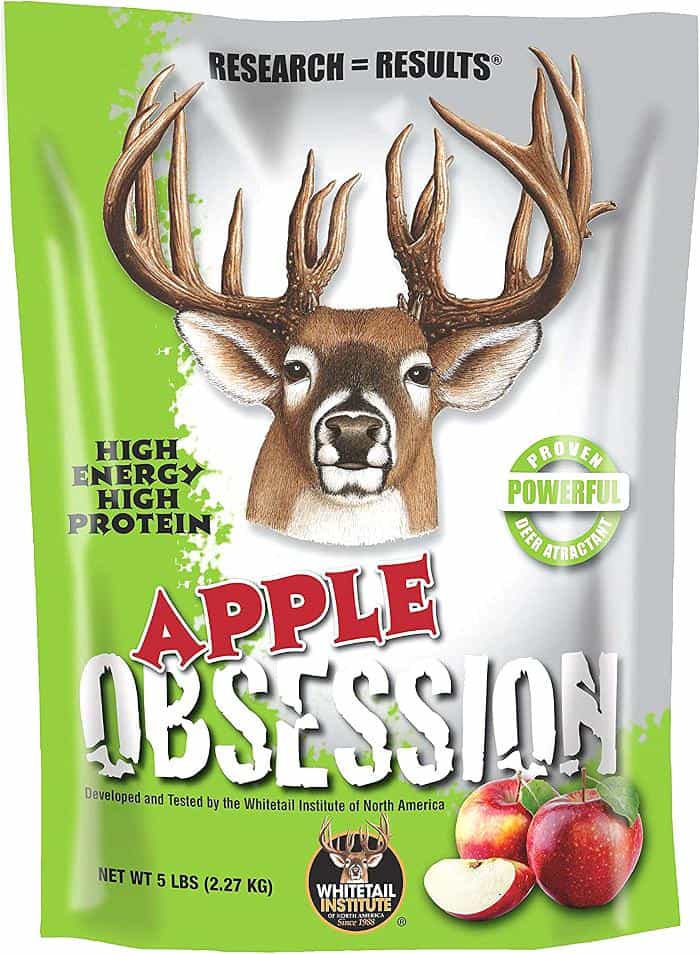
Unnatural or Curiosity Based Scents
These types of deer scents are designed to attract deer based on the strange smell or piquing their curiosity to investigate. While deer can be somewhat skittish in nature, they also have a certain level of curiosity, which can be used for attraction purposes.
Being such a scent-based species, the curiosity-based scent attractors play on their sense of curiosity to investigate unknown odors.
Some examples of curiosity scents that I’ve seen used include:
- WD-40 (yes, the same one that works for nearly everything)
- Pineapple
- Banana
- Twinkies (I suspect the sugar is the draw)
- Bar deodorant (have an acquaintance who swears by it)
I’ve had the best luck with the following scents in the following order:
- Sex scents – Hands down my most successful scent product, especially during the pre-rut, rut, and post-rut times.
- Food Scents – Most effective for me during off rut times of the deer season.
- Curiosity Scents – The least effective option in my experience.
The Best Time to Use Deer Scents or Lures
A key aspect of deer lures is knowing which type of scents to use and when to use those scents. Here’s a quick overview of each portion of the deer season and information about which deer scent types work best for that specific time period:
Off-Rut
The off-rut is generally considered any time during deer season that is not covered by the pre-rut, rut, or post-rut period. For the most part, this time frame includes any part of the season before the ten days leading up to the pre-rut phase and any time after the post-rut stage.
During this portion of the season, your best bet is food-based scents. If you don’t have any success with food-based aromas, you could try curiosity-based scents as a secondary option. However, I find that food-based scents are the best option during this period.
Pre-rut
The pre-rut phase is generally considered the ten days leading up to the full rut. In this phase, depending on the time of year, bucks are typically coming out of velvet and trying to establish a hierarchy position through posturing and sparring. Sparring is mock fighting or light fighting without any injuries.
During pre-rut, sex-based lures aren’t all that effective yet, as the necessary physiological changes in a buck’s behavior for mating have not occurred yet. Therefore, I find food-based deer lures the best option in this phase.
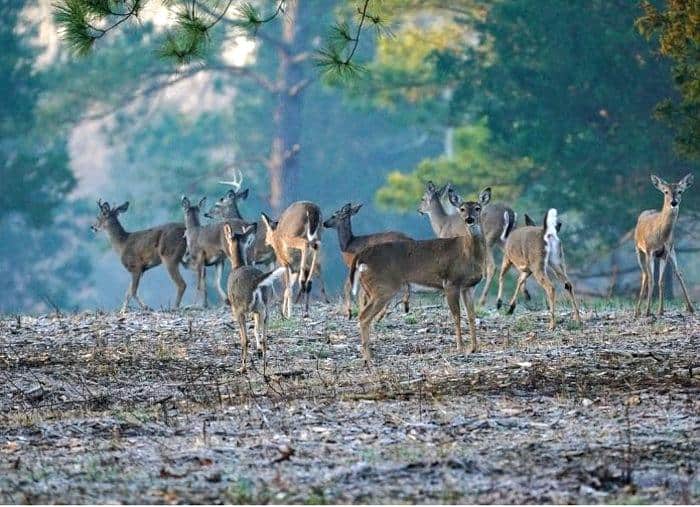
Full rut
Bucks are flooded with testosterone when the full rut kicks in, making them overly aggressive and determined to mate with every hot doe. During this phase, don’t waste your time with any other scents or lures other than sex-based scents. Bucks are not eating during this phase, so food-based scents or lures are nearly useless.
I find doe-in-heat urine or doe-in-estrus urine to be the single best scent to use during this period, and it can produce amazing results.
Post-rut
During the post-rut phase, several things may be going on all at once:
Some bucks are exhausted and change over to resting and eating as much as possible.
Some bucks are still feeling the effects of the rut and may still be chasing does and trying to mate, especially as the first wave of bucks begins to abandon the mating process and migrate over to rest and food.
A second wave of does come into heat in a smaller, secondary rut process. Then, the bucks who are still in rut will transition over to chasing the does who recently went into estrus.
Because so many different activities and behaviors may happen simultaneously, this phase has a few different scents or lure possibilities. Of course, sex-based scents will still be the best producer for bucks still in rut or waning down from the rut. However, for the males that have finished the rut or are about the exit the rutting phase, food-based scents will be your best option as these males are ravenously hungry and need to pack on weight to survive the upcoming winter conditions (depending on the climate).
FAQS
Here are some frequently asked questions or inquiries that I see being asked about deer scents or deer lures:
Does doe urine work?
Fresh doe urine or doe estrus urine is the most potent natural deer attractant available for male deer. The one caveat is that it’s really only effective during the rut phase of a deer’s typical lifecycle. However, during the rut, bucks are almost biologically forced to follow the scent of a doe in estrus.
A quick story to illustrate my point:
Several years ago, I was hunting a leased piece of land and had caught several nice bucks on camera before the season. I had taken off work for the predicted peak of the rut to be in the woods.
I had wrapped an old sweatband around one boot and used it as a scent trail with fresh doe in heat urine as I neared my stand. I had one target buck on my mind, but he never showed. However, I saw at least seven different bucks come by my stand, with a few coming by more than once with their noses to the ground on my scent trail or another doe trail. After dark, I waited until things quieted down and tried to slip out of the woods to my truck quietly.
However, I had forgotten about the urine sweatband on my boot as I quietly walked out of the woods. I walked nearly two miles to my truck in complete darkness. At my truck, I started taking off my gear and heard noises of something coming through the woods towards me. Not wanting to scare any deer, especially the big boy, off, I didn’t turn on a light or flashlight to determine the noise source. Instead, I eased into my truck and quietly closed the door. I hadn’t started the truck yet and was checking a message on my phone when I heard a noise as if something had gently made contact with the driver’s side of the truck.
I flipped on my flashlight and was surprised to be almost face to face with a six-point buck standing about a foot from my door with his nose to the ground. He was just as surprised as me and took off running the other way. As he did, I caught two more bucks behind him who were also nearby with their noses to the ground.
As near as I could tell, these three had picked up my scent trail as I walked out to the truck in the dark and followed that trail all the way to the side of my truck. Had I taken just another minute or so to take my gear off, I suspect I would have met the bigger six on a more personal level just outside my truck.
These three bucks appeared to have little to no fear of my truck, its potentially foreign smells, or my scent as I removed my hunting clothes and boots into a scent bag. Instead, they had one overwhelming and primary focus that evening: find the doe who made that scent and try to mate her. I still joke with friends that, had I been a little slower undressing that night, I might be part of some buck’s harem of does now ????.
How far away can a buck smell doe urine?
Several different factors can potentially impact the distance that a buck can detect or smell the urine of a doe in heat. Those factors include:
- The freshness of the urine used
- Weather conditions like temperature, humidity, etc.
- Wind direction
- The time that the urine was deployed
From a scent perspective, bucks have two potential ways to detect the scent:
- Airborne scent
- Ground scent
Although I don’t think that deer researchers know the exact answer yet, here are my thoughts:
In general terms, a deer can detect a human scent from as far as ¼ a mile away (under ideal conditions). Although doe urine is more concentrated, it’s also typically deployed on the ground, so the airborne scent doesn’t have the opportunity to travel as far. A buck in full rut can most likely detect it airborne from at least several hundred yards away (under those same ideal conditions).
Since ground scent is more difficult to initially detect (at least in research with tracking hound dogs) compared to airborne scent, I’d estimate that a buck can most likely detect fresh doe urine on the ground from at least several hundred feet away. Then, once he’s located the actual urine track, following the doe’s direction of travel is easy for his nose.
Understanding how deer scents and deer lures work, in conjunction with the optimum times to use them, can significantly increase your chances to bag that big one for the wall.

Born and raised in Indiana, Brantley spent his youth chasing deer and turkey and, along the way, developed a passion for bowhunting. Although he still enjoys other types of hunting, his true passion is bowhunting, and he has or will author most all the bowhunting content on this site. Outside of work, Brantley is married and the father of two beautiful little girls. Brantley has worked in the hunting industry, with an emphasis on archery and bowhunting, for more than ten years.

